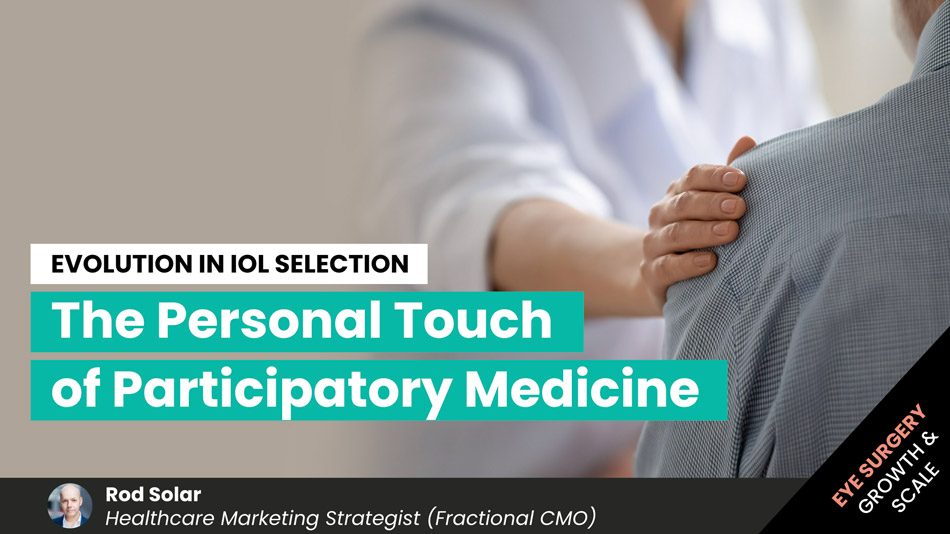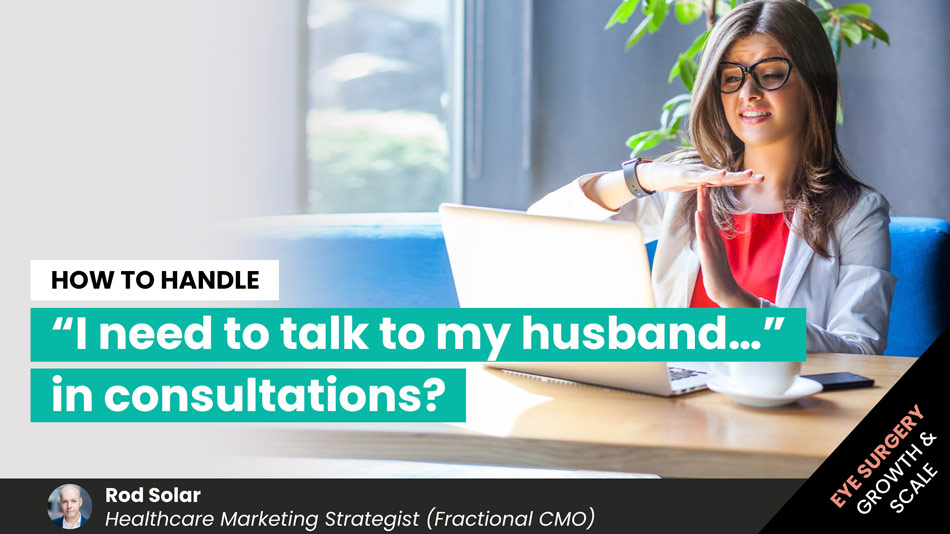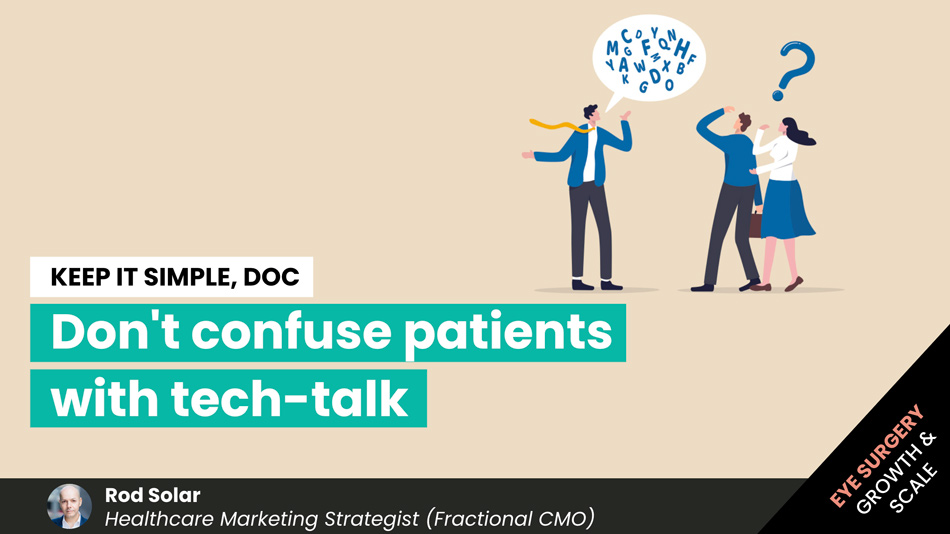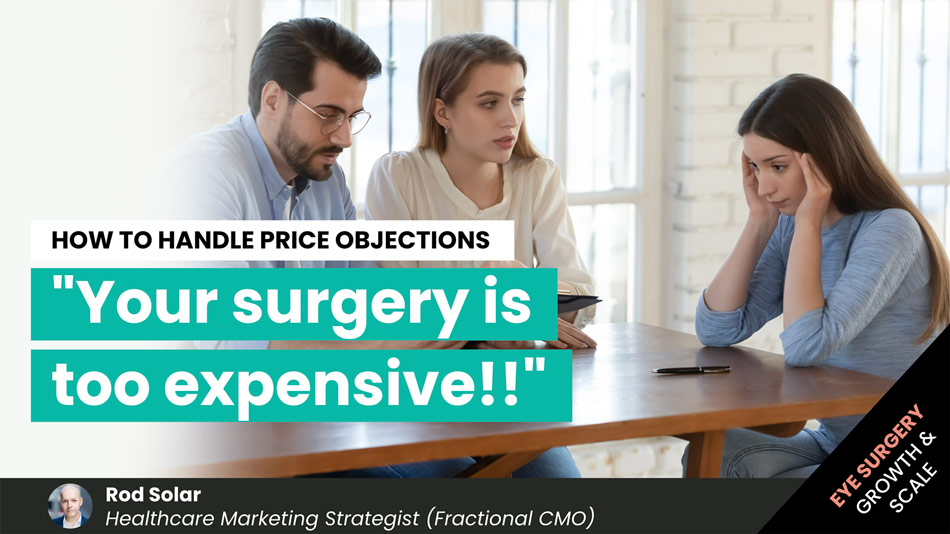The Consultation Process
Note: This is an edited transcript of the material we present in the above podcast episode.
Rod Solar: One of the biggest challenges that you’ll face at consultations when you’re in private practice, is doing everything you can in order to get the patient there in the first place.
Spending all that money on marketing, inviting them on the phone, having them go through your whole consultation for potentially an hour, two hours, or maybe more. Then at the very end of that consultation saying, “Look, doc. It’s been really, really informative, but I need to think about it.”
Now, it’s totally acceptable for people who genuinely need to think overnight, or over a few days, about a decision that’s really important to their lives, to have the time to be able to go home and truly think about it.
But, here’s the thing.
How many times have you thought when, in a sales situation, when the salesperson says, “Well, what do you think, doc? Are you interested?” How many times have you yourself said, “It’s all been very interesting, but I want to think about it,”, while you have absolutely zero intention of following through with a purchase decision? I’m willing to bet that happens a lot more often than you’re willing to admit.
Refined over 20 years, this formula works.
Now, what we’d like to do is we’d like to make sure that everybody who needs to go and think about it, well, they truly can go. But those who are just using it as a stall, or a reason for not giving you the real reason why they don’t want to go ahead, well, that we can do something about that.
So, what I’m going to do, is I’m going to share with you the consultation process that has taken us probably about 20 years to refine and develop after visiting hundreds of different clinics, observing what they do, seeing what works and modelling a pathway that enables people to take the patient from the first moment that they arrive (even before) and create the environment for them to get ready to buy, all the way through, say a 90-minute to two-hour to potentially three-hour process, where at the end, they feel really, really open with you, enough to reveal to you what their true objections are. Or, ultimately (ideally), say, “This has been great and I want to move forward. I’ve done all the thinking now and I’m ready to go.”
Write an exciting confirmation letter
How do you do that? Well, I’m just about to give you the insight into that pathway. I don’t have a lot of time right now to go into great specifics, but I’m going to give you the big blocks. So here’s how it goes.
First of all, you begin with a confirmation letter. That confirmation letter is the beginning of your consultation process. It typically starts shortly after you’ve actually made the appointment on the phone. That confirmation’s got to be exciting. It’s got to reveal to them who you are and how you are so enthusiastic about helping them get over their before state and into their after state, that they really feel it jump off the page. So it’s got to be written personally, from a person, to another person.
Try to avoid the passive voice, get active and take personal responsibility for their experience. Make sure that you’re absolutely clear on what’s going to happen at the consultation. Use it as an opportunity to build value. List all the things you’re going to do, list how long it’s going to take,
And here’s the kicker:
Make sure that you let people know the price range at which they’re going to be expected to pay based on whatever criteria that you can collect at the phone call. This is essential.
Otherwise, you might end up having a lot of people who visit with you at your appointment, who, really have no intention to pay whatsoever and just use, “I want to think about it,” as really an excuse to basically say, “Doc, I had no idea how much this was going to cost. I can’t afford this.” Most people are unwilling to say that. Instead of that, give them the pricing information in the confirmation letter and make sure that they understand what they’re getting into.
At the same time, give them a good idea of how long that consultation’s going to take so that they can plan accordingly. Then, give them all the instructions and mention all the attachments that you provide. An extra tip is to provide a registration form that they can fill out, even before they come to the consultation, so you can save time when they get there.
Here’s another little special trick:
If your appointment diary tells the patient that it’s 9:00, instead, tell them to arrive at 8:45. Don’t tell them to arrive early because then they might optionally decide to omit that part. Instead, tell them their appointment starts at 8:45. That way, if they’re late, they arrive at 9:00, no harm done. Furthermore, if they’re there at 8:45 and they haven’t completed the forms, then they’re able to complete the forms at their leisure within 15 minutes and nobody gets delayed.
Perfect your customer service journey
Now, the patient has come in, and they’re feeling enthusiastic (I hope) but they’re probably feeling a little anxious as well. What do you do? Well, it all starts with the reception. Reception is your front face. Reception is your best foot forward; your first impression. I instruct all receptionists to stand up from the desk, shake hands with the patient, and say, “Welcome to the clinic. Thank you for coming.”
With that great introduction, you’re immediately addressing the patient’s need to be respected as an individual, to be recognised as somebody important because they really are genuinely important to you.
Then, you instruct the receptionist to make sure that they offer to take the patient’s belongings, whether it’s their coat, or any bags, put them in a secure location and potentially, as well, lead them to their seat, give them the form to fill out, invite them to fill that out, let them know how long they have to fill out, and give them an expectation of when the next person in the line is going to go see them; which is the patient liaison (which I’ll get to in a second).
Then, you offer them a drink. “Would you like tea or coffee?” Instead of telling the patient, “Oh, the tea and coffee machine is over there, go get it yourself.” No, you actually go, as the receptionist, to the tea and coffee station, prepare the drink for them and bring it back to them. That’s proper service.
Then, once you’ve returned with the drink, you let them know, “The facilities are over there should you need them. The WiFi’s over there if you need it. If you need a phone, just let me know and I’ll be happy to help you. If you have any other questions, I’m right there. Happy to help.” All right? Now, that’s good service. That’s five-star service.
Many, many clinics aspire to produce that kind of level of service, but they have no path or plan to do so. They certainly don’t hire the right people or train them appropriately. All of that’s embedded in that step.
Train your staff and assign the correct roles
Then out comes a patient liaison or a patient coordinator. Now, this is a position that a lot of clinics don’t have and it’s a massively important position. Most clinics have a receptionist. I don’t expect the receptionist to do this role because reception has to be ready for any patient that walks into the room or exits the room.
That’s how important their job is. They have to be on all the time. They’re on stage 100%. The patient liaison, however, they are somebody who you hire for their sales ability. They are somebody who truly believes in the value of what you offer, to the point that they will do whatever is ethically within their power to ensure that the patient who comes in for a consultation, books the next step or we know what their objection truly is. That requires special skill sets, which really you should train.
Now, it is something that we offer to help you train your staff to do that, but you could possibly find other sales trainers who perhaps are in different fields, who might be able to translate some of what they do into the healthcare context.
I think most of our customers appreciate the fact that we know all about healthcare so we can do that for them.
But moving forward, I’ll tell you a little bit about what the patient liaison is meant to do. 15 minutes after the patient arrives, the patient liaison comes out, gets down to their level, shakes their hand and ensures that the patient feels welcomed. Then they invite them into their room. Oh yeah, by the way, they’re supposed to have a separate room. You can’t have these kinds of conversations that I’m about to suggest in public, in a waiting room or in a hallway or at the reception desk. It has to be in a private room. Most clinics overlook the need to build a room like that. I’m going to suggest that you probably renovate.
It’s that important.
You invite the patient into the room, you sit them down and you warm them up. Why do you warm them up? Well, warm-up is important because we’re all human beings. We all have anxieties. We all have tensions. Our aim is to reduce those tensions in the warm-up and make sure that patients feel open enough and relaxed enough to be honest with us. That’s the first step in getting the honesty that will ideally (hopefully) lead not to, “I want to think about it.” After you’ve done a bit of a warm up, you’ve just talked about things that have nothing to do with the consultation or the treatment, just personal things that the patient can answer, then you get into an intent statement.
That intent statement is all about…
“Okay, patient. Well, here’s what we’re going to do. Here’s our agenda for the day. First, we’re going to have a little chat. Then I’m going to introduce you to the practitioner, who’s going to conduct numerous different exams and tests.” Sometimes I like to say “measurements”, if that’s appropriate in your context because measurements sounds less scary than exams and tests. “They’re going to assess your suitability for what we can offer you. Then they’re going to return you back to me so that we can discuss schedules and payments, should you want to be patient and should you be suitable.
Now, not every patient is suitable. You should be aware of that. In case you’re not, we’ll be really honest with you because we’re really conservative here and we want to make sure we only select the right patients for the right treatments. Does that make sense?” Of course, the patient’s going to say: “Absolutely! That makes sense. I don’t want to be invited to do something that I’m not suitable for!”. They’re going to be right there with you.
Then you say, “However, on the other hand, if you are suitable, then I’ll definitely be very clear in what you’re suitable for, provide you with all the options to take it to the next step, at which time, I’ll ask for payment. Does that sound okay with you?”
Now, here’s what you’ve done.
You’ve ensured that the patient understands that they have to now think about this decision here and now.
This is the time to really get serious. This is the time to ask questions. This is the time to listen. This is the time to remain fully engaged because the time that they’re going to be asked to make a decision is at the end of the appointment. Does that make sense?
Now, if we don’t tell people that, if we basically just never mention the fact that we’re ever going to actually ask them to commit to the next step, what we’re doing is we’re leading them down a path that is very even and flat and easy. Then at the very end of that path, what we’re going to do is we’re going to expect them to jump a big, big wall and jump over a big obstacle to say “yes” to us.
What do most people do in that circumstance? They go, “Wow, that’s a really big wall. I think I’m going to think about how I’m going to go over that wall.”
Instead, what I want you to do is this:
I want you to build a staircase. You begin with that first yes. Then you build another yes. Then you build another yes, and then another yes, and then another yes. Finally, you get to the point where that last yes, looks like a little tiny step, not a big, big wall.
NOTE: The best way to answer that nagging question about practice growth or marketing or patient volume in the back of your mind is to book a free 15-minute compatibility call. Get some options and go away with a clear idea of what’s possible.
Condition your patients to say “yes”
You’ve conditioned the patients to say yes to you. You’ve conditioned them to trust you, and what kicks in here is the influencing principle of consistency. Most people, after they’ve said yes, and yes, and yes, and yes to you, are now conditioned to say yes. They will most likely want to follow through with the yeses, as long as they’re all in alignment.
“Are you interested in me asking these questions?”
“Yes.”
“Are you interested in getting from the ‘before’ state to the ‘after’ state by the deadline you’ve shared with me?”
“Yes.”
“I’ve identified that you’re suitable. Are you still interested in moving forward from the before state to the after state?”
“Yes.”
“Do you have any questions or are you happy to move to the next step?”
“Yes, I’m happy to move to the next step.”
And the final question:
“Well, this is this date, that is that date. Which one do you prefer?”
Now, that’s not a yes question anymore; it’s a choice question. Now, the idea is basically that the yes is implied. The patient is already moving forward to the next step. It’s just a question of ‘what do they want? What’s on the menu? What will I choose?’
Prepare your question clusters
Now, moving back to the process of the consultation, after the patient liaison has communicated with them the intent statement, they go through a series of questions. I prescribe about 10 question clusters. I don’t have time to go through them all, but if you’re interested, then I encourage you to look at the resources that we provide through liveseysolar.com or other different websites on which we are sharing some of those resources, like this one. Then you’ll be able to avail yourself of some of the prompts and questions that we tend to use that work really well.
In a nutshell, what I’m trying to get you to do, or the patient liaison to do, is to ask questions that get patients emotionally invested, and then ask questions that get them rationally structured around making a decision that they can really commit to. After that’s done, and that takes about 10 minutes, you ask them a confirmation question. Something like, “Well, it sounds like I understand pretty much what it is that you’re looking for. I’ve asked you questions about your current, ‘before’ state. I’ve asked you questions about your ‘after’ state. I’ve asked you questions about when you want to do this. If we can get you from point A to point B at the timeline that you’re interested in, would that be something that you’d like to go ahead with?”
The handover stage
There’s another yes. Of course, the patient’s going to say yes at this stage. Why wouldn’t they? That’s why they came in the first place. Then you do a handover and transfer the right for all of that trust that you’ve earned to be handed over to the practitioner. You go in front of the practitioner, sometimes you can go ahead of time and communicate to them behind the scenes, but I instruct people to also be very, very conscious of doing this handover in public. What I mean by that is in front of the doctor and in front of the patient.
What I do is something like this, “Doc, let me introduce you to our patient,” by name, everyone. “This patient has this before state. It’s really impacting their life in negative ways. This patient would also like to get to that after state. They’d have a really great life as a result of that. The timeline for them is say three weeks or by March,” right? “Is that okay?” Then the doctor goes, “Yeah, that sounds pretty good.” Then you turn to the patient, as the patient liaison, you say, “Is that okay, Mrs. Patient?” She says, “Yep, sounds good to me.”
Now, what has the patient done? They’ve effectively, psychologically, agreed that they’re going to go forward with the procedure on the timeline that they’ve suggested. Why? Because you’ve gotten that agreement in front of everybody. Now everybody knows. So, it’s going to be really difficult for that patient, it’s not that you’re putting pressure on them. They’re going to be putting pressure on themselves, but it’s going to be really difficult for them to then turn around and say, “Well, I’ve answered all your questions honestly, but now I want to think about what I want.” They’ve already told you what they wanted. They told you when they want it. What’s left other than to say yes?
The examination stage
Now, the process of the examination takes place. I don’t have time to tell you all about how that works, but I’ve got loads and loads of material on how to conduct proper examinations, including how to talk about tests, how to demonstrate your credibility, how to communicate risks, how to make strong recommendations so that you ensure that the patient truly understands what it is that you’re telling them to do. How you handle objections and questions and how do you ensure that the patient leaves without one shadow of a clinical doubt that they are in fact suitable for the procedure, what they’re suitable for and what that entails.
Then that practitioner then brings that patient back to the patient liaison, that person that they generated a trusting relationship previously, then that patient liaison has the job of closing that patient.
That’s super important.
The patient liaison can’t just come in at the end and look like a bill collector. They have to be the same person who generated the trusting relationship to begin with. That same person now, who’s invested in that trust, then commits the patient to the next step.
That next step usually is, as I’ve suggested, “Here’s a couple of dates, which one works for you? Here’s a couple of times, which one works for you? Great. Now that that’s sorted, in order to reserve those dates in the diary, now, all I need is to take a small investment and initial deposit in order to hold those dates.”
Now that invokes the principle of reciprocity.
I’ve done something for you, book these dates. Now you do something for me, commit with this small initial deposit. That creates that small investment, which is much less to think about than the big investment that comes after. You take that investment, you process it and you move on with your life!
The closing stage
Now, critically, the doctor, once they leave the patient with the PL, has handed over, told everybody what’s involved, that all objections have been covered and that they’ll see the patient at the treatment, creating this atmosphere of assumption. We all assume now, the patient liaison, the doctor and the patient themselves, that the only movement forward is towards the direction of treatment, towards that after that they’ve been talking about throughout the entire consultation and that we’ve encouraged them to buy into.
Finally, at this stage, the patient may have some objections, but importantly, they now have not been surprised. They know that they had to be thinking about it throughout the consultation. Any objections that they raise, the patient liaison should be able to deal with because they understand who the patient is and have all the information at their disposal in order to balance any objection with the after. If they can balance that, that creates perspective. That is typically sufficient to overcome objections.
Now, finally, the patient still might say, “This has been really good. I really, really like what I’ve seen, but I still want to think about it.”
Here’s a suggestion.
When you hear that, be very calm, very relaxed and simply ask, “It sounds like you have some concerns. Can you share some of those with me?”
Invite the patient to share with you what it is that they have to think about. Because I think you know, as well as I do, that most patients don’t really go home and think about it. Most patients are telling you that because they have some concerns. It’s up to you, as the doctor, and the patient liaison, in both your respective areas, both clinically and administratively, to handle all the concerns that the patient has so that they can feel like all their obstacles have been removed out of their path and the only direction is to move forward towards after that they most seek.
So I hope that’s been helpful. I hope that through executing processes like these (and they’re not easy) they take a lot of good hiring, they take a lot of good training and there’s a lot of obstacles in your path that you might find might get in the way. But if you plan this out appropriately, and if you get somebody in to help train your staff to do it, then I’m confident that it’s going to result in a significant increase in conversions and a much lower amount of “I want to think about it”.
NOTE: The best way to answer that nagging question about practice growth or marketing or patient volume in the back of your mind is to book a free 15-minute compatibility call. Get some options and go away with a clear idea of what’s possible.
About the author
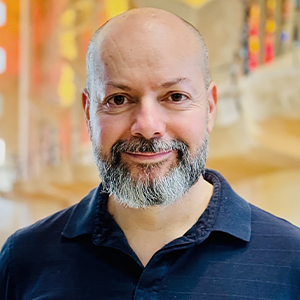
Rod Solar
Founder & Scalable Business Advisor / fCMO
Rod Solar is a co-founder of LiveseySolar and a Scalable Business Advisor for its customers. Rod mentors and coaches eye surgery business CEOs/Founders and their leadership teams to triple their sales, double their profit, and achieve their “ideal exit”.
Related Posts
Meet our Co-Founders
We’re passionate about helping leaders of high-quality, growth-minded practice owners double their practice revenue

Rod Solar
Founder & Scalable Business Advisor
For over 20 years, I’ve helped ophthalmology entrepreneurs scale their private practices. I specialise in doubling revenue within three years by offering a proven framework, hands-on experience, and a team of experts who implement what works. We take the guesswork out of growth and scale, so you can focus on delivering exceptional patient care while maximising the value of your business.
LiveseySolar completely transformed the way we were approaching this… We’ve gone from having just the dream of having a practice to having a practice up and running with people making inquiries and booking for procedures… It’s extremely pleasing. We feel lucky we connected with LiveseySolar.
— Dr Matthew Russell, MBChB, FRANZCO, specialist ophthalmic surgeon and founder of VSON and OKKO

Laura Livesey
Founder & CEO
I’m the co-founder & CEO of LiveseySolar. I’ve developed powerful eye surgery marketing systems that increase patient volumes and profits for doctors, clinics, and hospitals, since 1997.
Rod and Laura know as much about marketing surgery to patients as I know about performing it. They are an expert in the field of laser eye surgery marketing. They know this industry inside out. I believe that they could help many companies in a variety of areas including marketing materials, sales training and marketing support for doctors.
— Prof. Dan Reinstein, MD MA FRSC DABO, founder of the London Vision Clinic, UK






